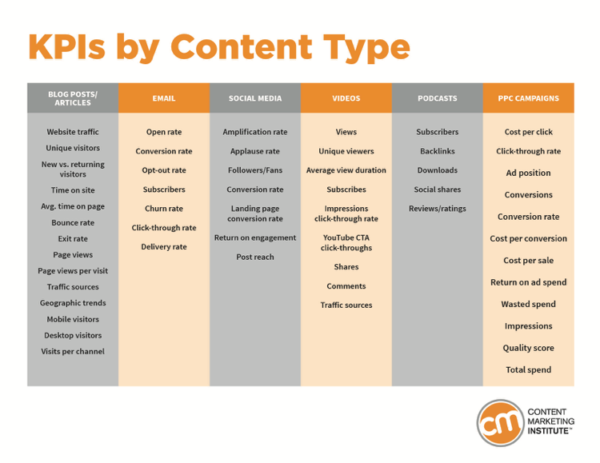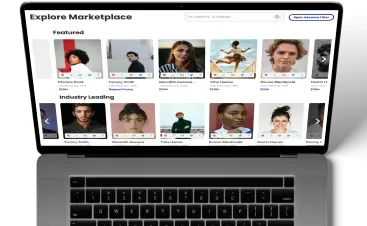You’re spending thousands of dollars putting out blogs, infographics, podcasts, social media posts and even sending case studies to your ideal prospects. But how do you know which content marketing efforts are paying off and which you need to scrap?
Content marketing is a top priority for 80 percent of marketers and accounts for 26 percent of B2B marketing budgets.
But without meaningful KPIs, content marketing is like navigating a ship without a map. You may be making progress, but without a clear destination and checkpoints, you won’t know for sure.
So how do you measure content marketing efforts?
In this article, we’ll explore 8 key metrics you can use for measuring content effectiveness.
What is content marketing?
Content marketing is a strategic process of creating and sharing valuable, informative, and relevant content to educate, attract, and engage your target audience.
Effective content marketing is centered around your ICPs, not your product or service. Just like any other marketing tactic, the ultimate objective is to maximize conversions and boost profitability.
This is why 73 percent of B2B marketers and 70 percent of B2C marketers invest heavily in content marketing as part of their overall marketing strategy.
Types of Content Marketing
There are many types of content marketing to choose from. The trick is to see which your customers prefer and what suits your product/service and brand best.
Brands either create content themselves, work with an agency to generate content, or work with influencers and creators to create UGC (user generated content) to distribute throughout marketing channels.
Successful companies use a combination to empower their buyers. Let’s look at some popular types of content:
| Blogs/ articles | Social media posts |
| Videos | How to guides |
| Podcasts | Memes |
| Infographics | Paid ad content |
| Emails | Testimonials/ reviews |
| Visual content | Infographics |
| Ebooks | Slideshare presentations |
| Whitepapers | Quizzes/tools |
Why is Content Marketing Important?
You need content to guide your buyers at every step of their buyer journey. That means you must have top-of-the-funnel (ToFU), middle-of-the-funnel (MoFU), and bottom-of-the-funnel (BoFU) content so buyers can make a well-informed decision.

The quality of content you put forward can benefit your business and marketing strategy. 83 percent of marketers believe in quality over quantity of content, even if it means posting less often.
Let’s dive into some notable benefits of high-value content marketing.
Benefits of high-quality content marketing
- Lead generation – People have more trust in brands with an extensive social and online presence.
- Organic Reach and low costs – Valuable content is viewed and shared more creating organic and enhanced reach.
- Increased traffic and conversions – Your content efforts educate and empower customers, persuading them to take action. It also shows customers you care about them.
- Data-driven insights – Content performance analysis allows you to make well-informed future marketing and business decisions.
- SERP rankings – When your content helps users, you rank higher on SERP (Search Engine Results Page).
8 Key Content Marketing Metrics
There are many metrics to measure content effectiveness. The combination you choose depends highly on your content marketing goals, which could be to:
- Generate more leads
- Increase brand awareness
- Increase conversions
- Boost engagement
Once you have a specific goal in mind, you can align it with the right metrics.
Consider this example. When you put out more content and answer more questions, you show up on SERP more and get more organic traffic.
But not all traffic translates into buyers. Ideally, 17 percent of your organic traffic should convert. That means your bounce rate is still going to be 80 percent.
Here neither traffic nor bounce rate can tell you about content marketing effectiveness.
So how do you measure content marketing success?
We have gathered a list of the eight vital content marketing metrics you need to keep your eye on.
Let’s dive in.
1. Impressions
If Google recognizes you as a ‘solution’ to a problem or a query it will make you visible high-up on the SERP. This means potential customers get to see you. The more impressions you get the more prospects you ‘reach’. More impressions are likely to translate into more conversions. Tracking impressions also determines how effectively your content is being distributed across different channels.
For example, if you get more impressions on your Facebook page than on your website, it means your content resonates better with your Facebook audience. Knowing this, you can allocate more resources and create content specifically for your Facebook audience’s preferences and interests.
Tools to use: Google Search Console, Google Analytics, HubSpot, Social Media Analytics, and CMS.
2. Visitors / Traffic
This may be pretty obvious but the amount of traffic or visitors your website and social pages are generating is a key indicator of how your content is performing. Types of traffic sources to monitor:
- Organic
- Direct
- Referral
- Social
- Paid search
Where do you get most traffic from? Which channels are converting more than others?
Refine your content marketing strategies to focus on channels that drive the most valuable traffic and adjust their content to align with your audience.
Tools to use: Google Analytics, Google Search Console, WordPress, CMS.
3. Bounce Rate
Bounce rate is when people visit your website but leave without visiting any other pages. If your bounce rate is high it could indicate a number of problems:
- Poor user experience
- Content is irrelevant, unengaging, misleading, or doesn’t deliver
- CTA is weak or missing altogether
- Slow page speed
High bounce rates keep you from raking well on the SERPs.
Tools to use: Google Analytics, CMS, HubSpot, Marketo, Hotjar. SEMrush, Ahrefs.
4. Conversions and Click-through rate (CTR)
The Click-through rate is the amount of clicks your content gets as opposed to the times it is shown. People may be viewing or consuming content but is it motivating them to convert or take action? This typically depends on how strong your CTA is.
The conversion rate is how many people out of all visitors did what you wanted them to do. This could be signing up for newsletters, booking demos, subscribing to mailing lists or completing purchases on your website.
Click-through rate and conversion rate give you insight into how compelling your content is. Higher values show that your viewers found your content engaging and relevant enough to take the next step. More than 60 percent of marketers measure the success of their content marketing strategy through sales.
Tools to use: Google Analytics, Google Search Console, HubSpot, Marketo, WordPress, SEMrush, and Ahrefs.
5. Shares and Backlinks
If your content is useful, answers questions, and helps solve users’ problems, it’s likely to get shared and mentioned in the form of backlinks. Especially if you’re getting backlinks from high-authority websites.
Backlinks are a great metric for evaluating content marketing success as they prove that your content is valuable enough to be mentioned and shared on external platforms. It also brings in more traffic and helps you rank higher on SERPs.
Tools to use: Backlinks Tools to use: BuzzSumo, Ahrefs
6. Engagement
When people like your content they are more likely to engage in the form of:
- Likes, shares, and comments
- CTR
- Email subscriptions
- Time spent on page
- Scroll depth
- Social media mentions
- Downloads
- Email open and click rates
Monitoring these is integral for effective content marketing measurement. It proves that your content is compelling, valuable, and relevant to your audience’s needs and interests.
Tools to use: MailChimp, Google Analytics, SEMrush, SurveyMonkey, HubSpot, Salesforce, Hotjar, Crazy Egg, Social Media Analytics.
7. Search Engine Rankings or Keyword Rankings
Keywords are the queries users type into Google while searching for solutions. Choosing the right keywords to rank for can give your business a competitive advantage and rank higher on the SERPs.
Pay close attention to what users are typing in Google to select the right keywords for your business.
Tools to use: SEMrush, and Google Search Console.
8. Revenue Attribution
Revenue attribution is an effective tool to measure the direct impact of your content on generating revenue for your business. It involves connecting specific conversions or sales back to the content that influenced the ultimate buying decision.
Revenue Attribution helps marketers strategize and create content that has evidently been well-received and converted in the past.
Tools to use: Google Analytics 360, HubSpot, Adobe Analytics.
Vanity Metrics and Actionable Metrics
While measuring content marketing effectiveness, it’s also important to differentiate the good metrics from the ‘vanity metrics’. Vanity metrics are those KPIs that don’t directly translate to conversions or sales.
Then why do so many marketers still chase after them? It’s because the purpose of vanity metrics is to help fine-tune your content for audiences on specific channels. These help you measure and strategize content marketing performance better.
Consider this example, while some may consider these vanity metrics, KPIs like reach, engagement rate, playlist inclusion, listener demographics, and listener retention are common metrics Spotify uses to drive Content Marketing strategy.

Alt text: KPIs for measuring content marketing effectiveness by content type
Where do you stand?
These key metrics will help optimize your content marketing strategy to best serve your ICPs, and lower costs by eliminating poor-performing content efforts and by maximizing RoI.
Create content that answers your consumers’ issues in a fun way, while empowering them to take action. And use these metrics to analyze and strategize accordingly.
Working with influencers to create content for your brand
By working with influencers and creators, you will be able to create unique and engaging content to distribute across your marketing channels. User and Creator Generated Content is a great way to continue delivering content and value to your customers, followers, and prospects as you enhance your content marketing efforts. To find influencers for your brand, simply create a free account on Glewee today and launch your first influencer marketing campaign in minutes!





